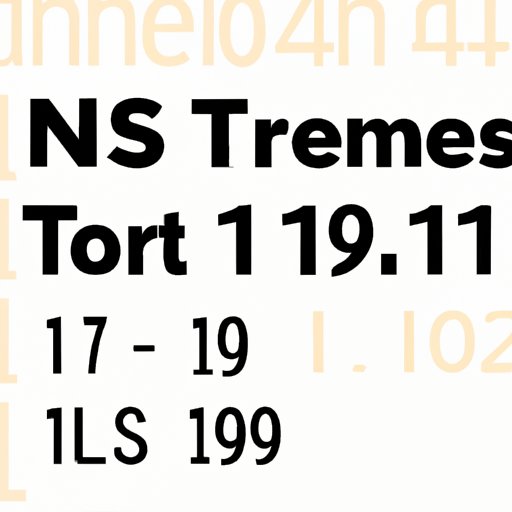
I. Introduction
If you are a non-resident doing business in the United States, chances are you have come across the term ITIN number. The ITIN number, or the Individual Taxpayer Identification Number, is a tax processing number issued by the Internal Revenue Service (IRS) to individuals who are required to have a U.S. taxpayer identification number but are not eligible for a Social Security Number (SSN). In this article, we will guide you through the process of obtaining your ITIN number, including all the requirements and documents you need to have.
II. A Complete Guide to Obtaining Your ITIN Number for Non-Residents in the U.S.
If you are a non-resident individual or entity earning income in the U.S., you are required by law to have an ITIN number to file your tax returns. An ITIN number is necessary for individuals who are not eligible for an SSN such as, nonresident aliens, their spouses, and dependents who are not eligible for an SSN.
To obtain an ITIN number, you must complete an application and attach required documentation to verify your identity and foreign status. The requirements for obtaining an ITIN number are regulated by the IRS and include filling out IRS Form W-7, attaching valid tax returns or other supporting documents, or receiving an exception to the requirement.
III. 5 Simple Steps to Acquiring Your ITIN (Individual Taxpayer Identification Number)
Here’s a quick guide on how to obtain your ITIN number in five straightforward steps:
Step 1: Complete IRS Form W-7.
Step 2: Attach required documentation to your ITIN application.
Step 3: Mail your completed application and documentation to the IRS.
Step 4: Wait for your ITIN application to be processed (approx. 7-11 weeks).
Step 5: Receive your ITIN number from the IRS.
The supporting documentation you need to provide includes original or certified copies of identity documents, such as a passport, and proof of foreign status. You may be able to avoid sending original documents if you choose to work with an IRS authorized Taxpayer Assistance Center (TAC) or Acceptance Agent.
IV. The Ins and Outs of Applying for an ITIN: Tips and Tricks You Should Know
The application process for an ITIN number can be complex, and it’s easy to make mistakes. Here are some tips to help you navigate the process smoothly:
Tip 1: Make sure you are using the most current version of IRS Form W-7.
Tip 2: Ensure the accuracy of your supporting documentation and submit certified copies or originals.
Tip 3: Check your application for common errors, such as an incorrect birthdate or invalid address.
Tip 4: Avoid sending your application without all the required documents.
It is essential to note that incorrect or incomplete documentation or insufficient personal identification can delay or cause rejection of your ITIN application.
V. Navigating the ITIN Application Process: From Start to Finish
Once you have submitted your ITIN application, you can generally expect a processing time of 7-11 weeks. It is possible to track the status of your ITIN application on the IRS website or by phone using the Individual Taxpayer Identification Number (ITIN) hotline. It may also be helpful to work with authorized IRS Acceptance Agents or Taxpayer Assistance Centers if delays or other issues arise during the application process.
It is essential to keep in mind that the IRS is very strict in their ITIN rules and regulations, and using an Acceptance Agent can speed up the process and ensure correct documentation.
VI. Breaking Down the ITIN Requirements: What You Need to Know
Before applying for an ITIN number, you must gather and attach specific identifying documents with your application. The required documents include identification papers that verify your name and foreign status. The IRS requires original documents or certified copies of documentation.
Acceptable forms of identification and proof of residency are:
Identification: Passport (must not be expired), National Identification Card, or a U.S. Citizenship and Immigration Services (USCIS) photo identification
Proof of residency: Rental or Mortgage statement (full-page), Utility Bill (gas, water, electric, cable), Medical record, or valid driver’s license
It is important to note that the copies of all the documents must be certified by issuing agencies or a certified acceptance agent.
VII. Common Mistakes to Avoid When Applying for an ITIN and How to Fix Them
The most common mistakes when applying for an ITIN number include submitting the wrong form, sending incomplete applications, or failing to provide the necessary documentation. To ensure that your application is processed timely and accurately, make sure to review your paperwork carefully before submitting it. You will also want to check for any formatting issues or typographical errors, which can cause delays in processing.
It’s important to note that it’s not uncommon to receive a letter from the IRS requesting additional information, documents, or clarification. If your application is rejected altogether, there are several steps you can take to fix the mistake, such as submitting a new application, correcting any errors and resubmitting your documentation, and going through the process again as necessary.
VIII. Conclusion
Obtaining an ITIN number is a necessary and vital step for nonresident individuals or entities to earn income in the United States and comply with federal tax laws. The IRS provides clear guidelines on the requirements and documentation necessary for the application process, and working with IRS Acceptance Agents or Taxpayer Assistance Centers can help ensure accuracy. Remember, it’s essential to prepare your documents carefully, review your application thoroughly, and avoid common mistakes to avoid delays or rejections.
Whether you’re a foreign student, entrepreneur, or employee, obtaining an ITIN number can be a complex and confusing process. With the tips and guidance provided in this article, you can confidently complete your ITIN application, get your ITIN number, and remain compliant with U.S. tax laws.




